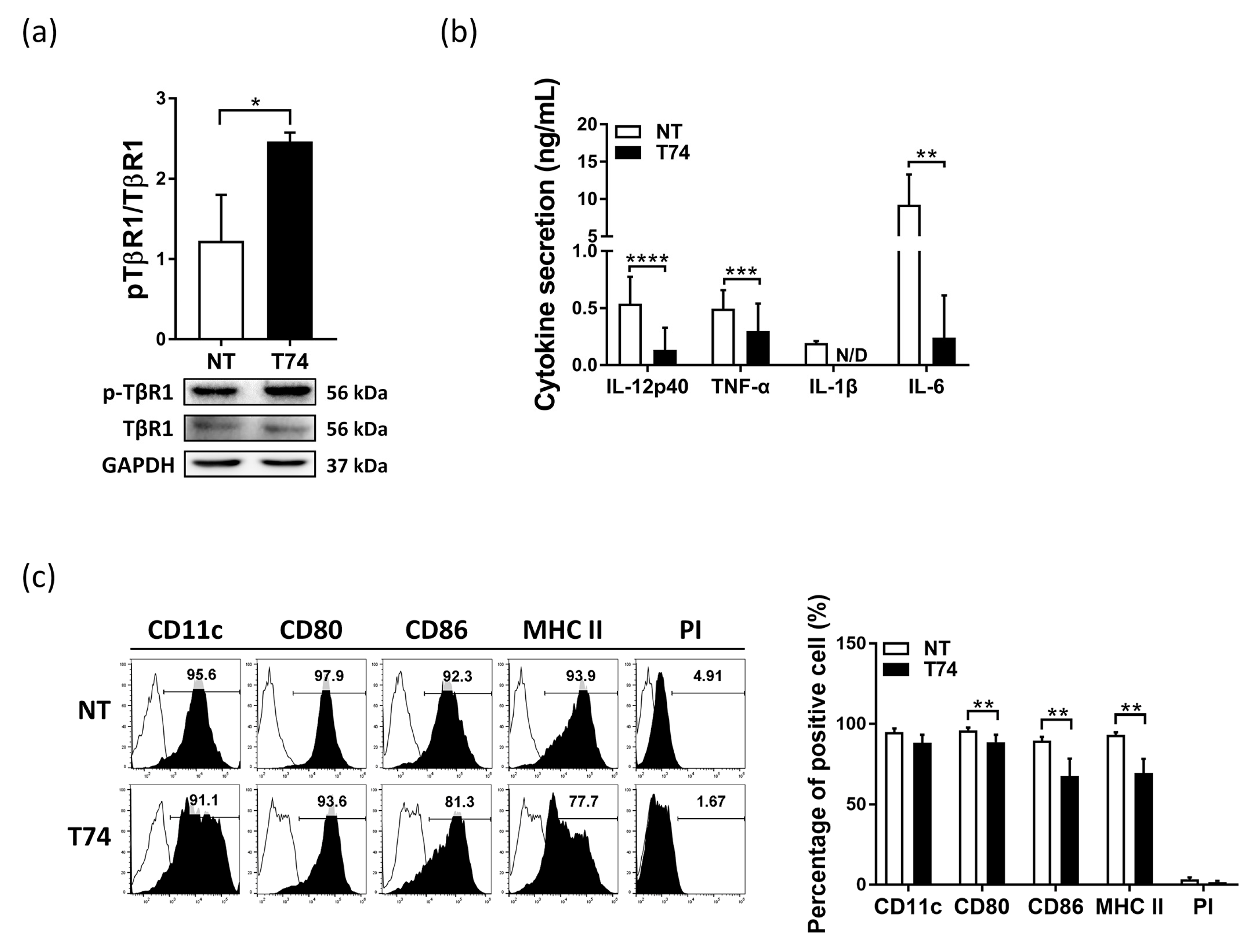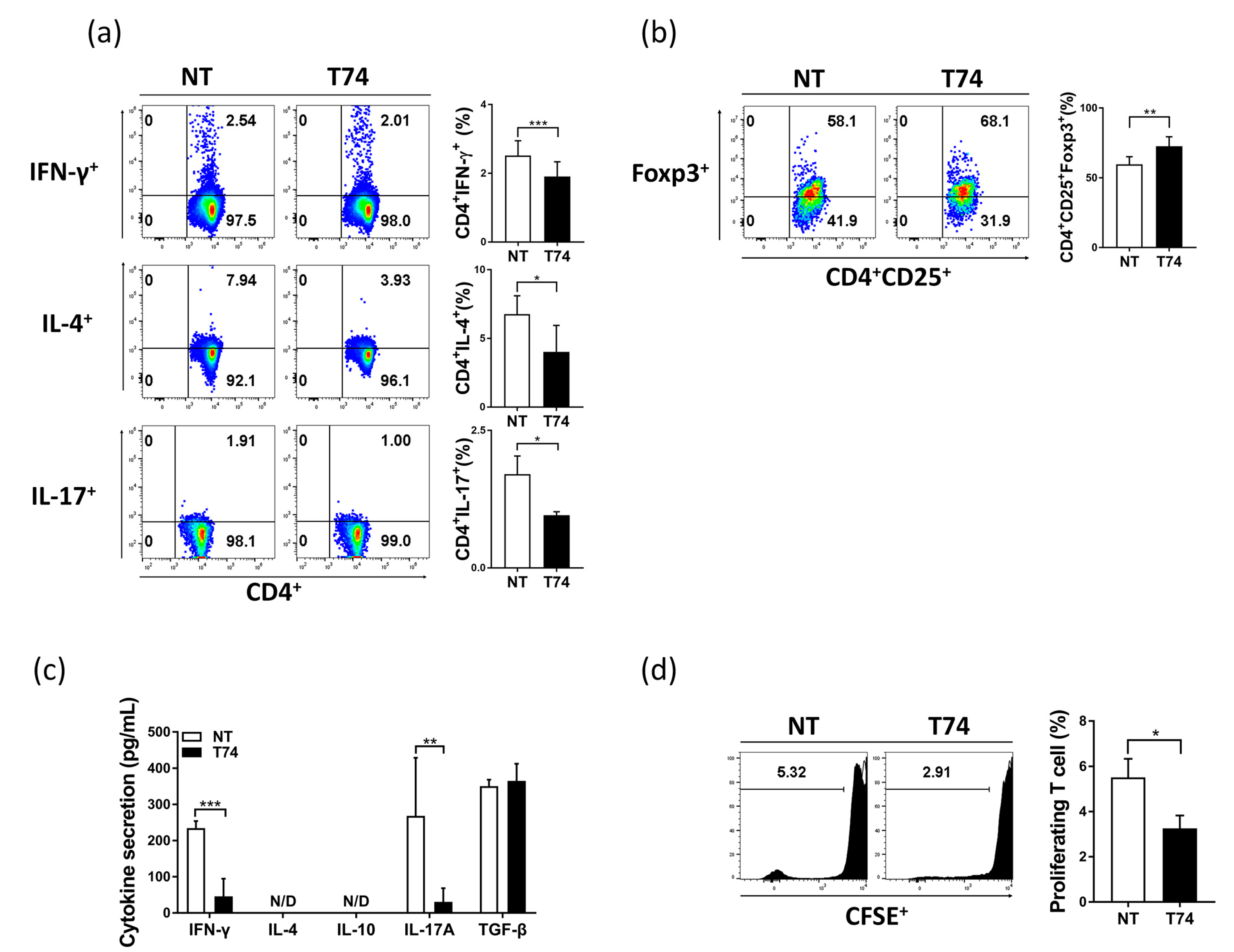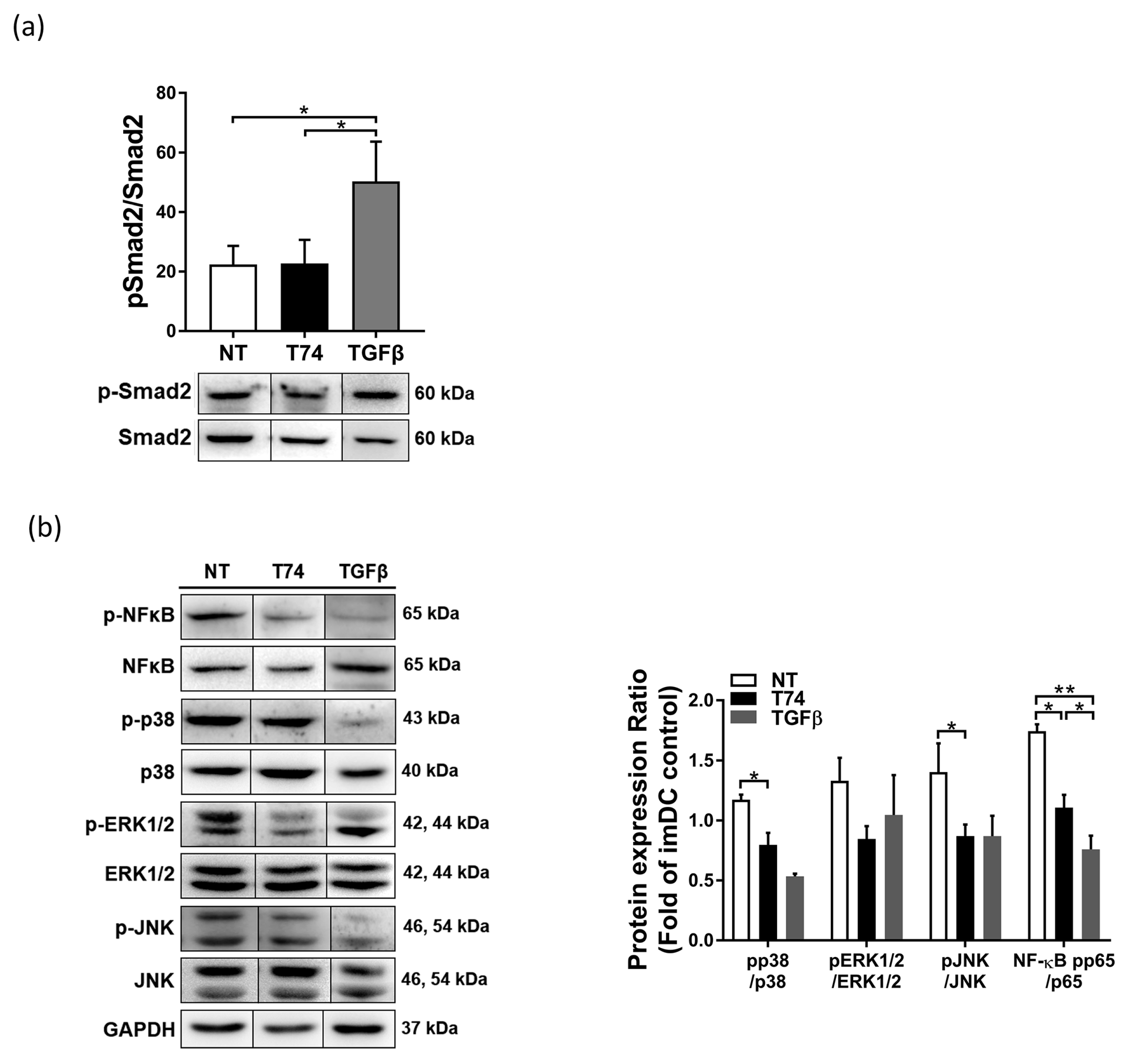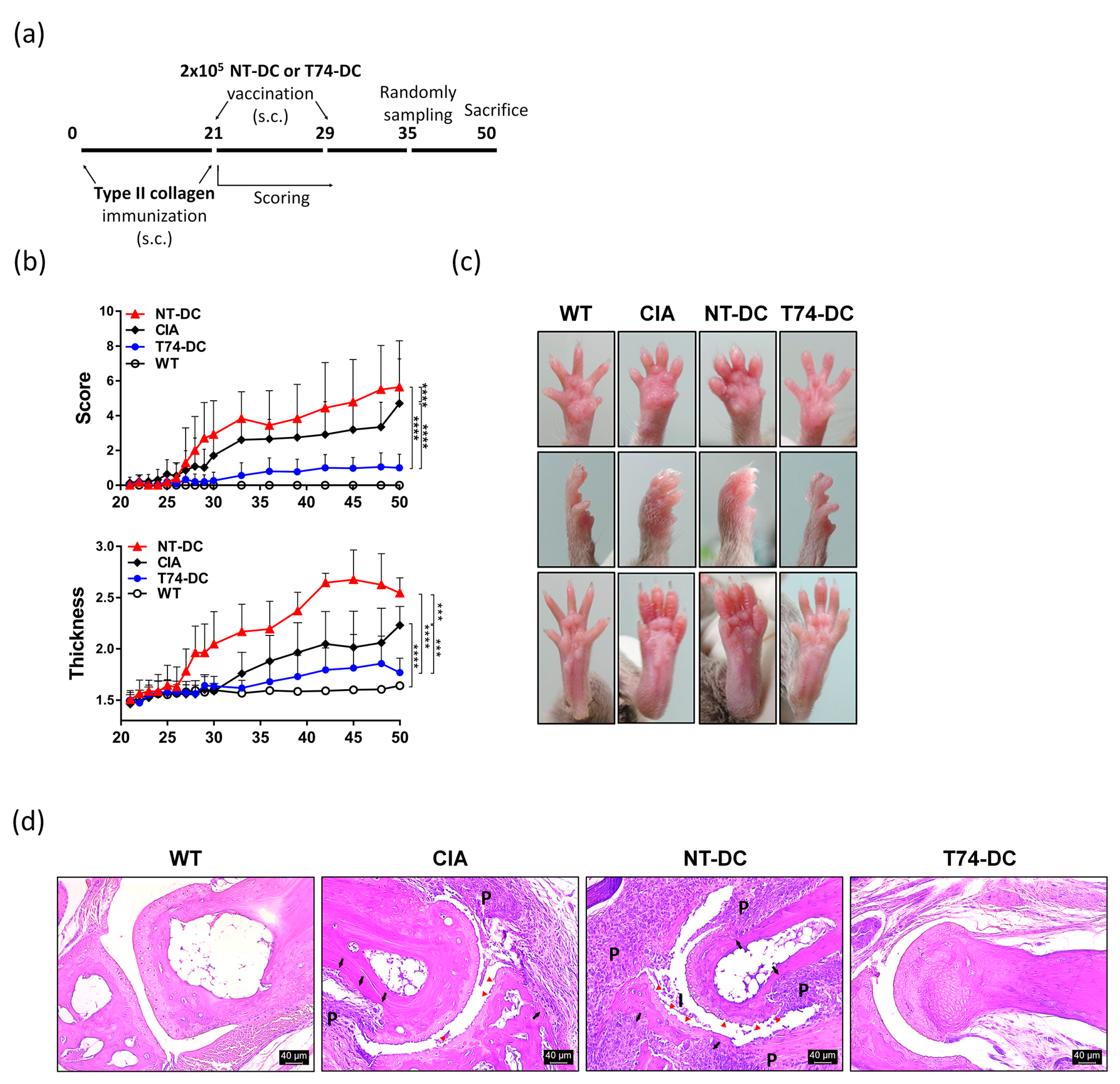Synthetic TGF-β Signaling Agonist-Treated Dendritic Cells Induce Tolerogenicity and Antirheumatic Effects
Abstract
:1. Introduction
2. Materials and Methods
2.1. Mice and Ethics Approval
2.2. TGF-β Signaling Agonist, T74
2.3. DC Generation Using T74
2.4. Flow Cytometry
2.5. Cytokine Measurement
2.6. Western Blot
2.7. Reverse Transcriptase PCR and Real-Time PCR
2.8. Co-Culture of DCs and Splenic T Cells
2.9. CFSE Cell Proliferation Assay
2.10. CIA Mouse Model
2.11. Histopathology
2.12. Statistical Analysis
3. Results
3.1. Effect of TGF-β Receptor Signaling Agonist T74 on DC Maturation
3.2. Effect of T74-Treated DCs on T Cell-Mediated Immune Responses
3.3. Change in Expression of mDC-Specific Gene Markers by T74-DCs
3.4. DC Signaling Pathways Affected by T74
3.5. Antirheumatic Effects of Type II Collagen-Primed T74-DCs on CIA Model
3.6. Effect of T74-DC Therapy on T Cell-Mediated Immunity in CIA Mice
4. Discussion
5. Patents
- Hyunjeong Kim, So Yeon Cho, Jimin Lee, Eosu Kim, Youngjoo Kwon, Soo-Yeon Hwang, Hyunji Jo, Seojeong Park, Younghwa Na. 2020. Composition for preventing, alleviating, or treating metabolic diseases. PCT/KR2020/003427, 12 March.
- Youngjoo Kwon, Soo-Yeon Hwang, Hyunji Jo, Seojeong Park, Younghwa Na, Eosu Kim, Jihyeon Jeong, Minsun Park, Hyunjeong Kim. 2020. Composition for prevention, amelioration, or treatment of cancer. PCT/KR2020/006868, 27 May.
Supplementary Materials
Author Contributions
Funding
Institutional Review Board Statement
Informed Consent Statement
Data Availability Statement
Conflicts of Interest
References
- Huynh, L.K.; Hipolito, C.J.; Ten Dijke, P. A Perspective on the Development of TGF-beta Inhibitors for Cancer Treatment. Biomolecules 2019, 9, 743. [Google Scholar] [CrossRef]
- Nassar, K.; Grisanti, S.; Tura, A.; Luke, J.; Luke, M.; Soliman, M.; Grisanti, S. A TGF-beta receptor 1 inhibitor for prevention of proliferative vitreoretinopathy. Exp. Eye Res. 2014, 123, 72–86. [Google Scholar] [CrossRef] [PubMed]
- Wang, H.; Chen, M.; Sang, X.; You, X.; Wang, Y.; Paterson, I.C.; Hong, W.; Yang, X. Development of small molecule inhibitors targeting TGF-beta ligand and receptor: Structures, mechanism, preclinical studies and clinical usage. Eur. J. Med. Chem. 2020, 191, 112154. [Google Scholar] [CrossRef] [PubMed]
- Wick, A.; Desjardins, A.; Suarez, C.; Forsyth, P.; Gueorguieva, I.; Burkholder, T.; Cleverly, A.L.; Estrem, S.T.; Wang, S.; Lahn, M.M.; et al. Phase 1b/2a study of galunisertib, a small molecule inhibitor of transforming growth factor-beta receptor I, in combination with standard temozolomide-based radiochemotherapy in patients with newly diagnosed malignant glioma. Investig. N. Drugs 2020, 38, 1570–1579. [Google Scholar] [CrossRef] [PubMed]
- Diesselberg, C.; Ribes, S.; Seele, J.; Kaufmann, A.; Redlich, S.; Bunkowski, S.; Hanisch, U.K.; Michel, U.; Nau, R.; Schutze, S. Activin A increases phagocytosis of Escherichia coli K1 by primary murine microglial cells activated by toll-like receptor agonists. J. Neuroinflamm. 2018, 15, 175. [Google Scholar] [CrossRef] [PubMed]
- Hartmann, W.; Schramm, C.; Breloer, M. Litomosoides sigmodontis induces TGF-beta receptor responsive, IL-10-producing T cells that suppress bystander T-cell proliferation in mice. Eur. J. Immunol. 2015, 45, 2568–2581. [Google Scholar] [CrossRef] [PubMed]
- Kim, H.; Cho, S.Y.; Lee, J.; Kim, E.; Kwon, Y.; Hwang, S.-Y.; Jo, H.; Park, S.; Na, Y. Composition for Preventing, Alleviating, or Treating Metabolic Diseases. PCT/KR2020/003427, 12 March 2019. [Google Scholar]
- Kwon, Y.; Hwang, S.-Y.; Jo, H.; Park, S.; Na, Y.; Kim, E.; Jeong, J.; Park, M.; Kim, H. Composition for Prevention, Amelioration, or Treatment of Cancer. PCT/KR2020/006868, 27 May 2020. [Google Scholar]
- Lim, D.S.; Kang, M.S.; Jeong, J.A.; Bae, Y.S. Semi-mature DC are immunogenic and not tolerogenic when inoculated at a high dose in collagen-induced arthritis mice. Eur. J. Immunol. 2009, 39, 1334–1343. [Google Scholar] [CrossRef] [PubMed]
- Ramalingam, R.; Larmonier, C.B.; Thurston, R.D.; Midura-Kiela, M.T.; Zheng, S.G.; Ghishan, F.K.; Kiela, P.R. Dendritic cell-specific disruption of TGF-beta receptor II leads to altered regulatory T cell phenotype and spontaneous multiorgan autoimmunity. J. Immunol. 2012, 189, 3878–3893. [Google Scholar] [CrossRef] [PubMed]
- Boomershine, C.S.; Chamberlain, A.; Kendall, P.; Afshar-Sharif, A.R.; Huang, H.; Washington, M.K.; Lawson, W.E.; Thomas, J.W.; Blackwell, T.S.; Bhowmick, N.A. Autoimmune pancreatitis results from loss of TGFbeta signalling in S100A4-positive dendritic cells. Gut 2009, 58, 1267–1274. [Google Scholar] [CrossRef] [PubMed]
- Laouar, Y.; Town, T.; Jeng, D.; Tran, E.; Wan, Y.; Kuchroo, V.K.; Flavell, R.A. TGF-beta signaling in dendritic cells is a prerequisite for the control of autoimmune encephalomyelitis. Proc. Natl. Acad. Sci. USA 2008, 105, 10865–10870. [Google Scholar] [CrossRef] [PubMed]
- Byun, S.H.; Lee, J.H.; Jung, N.C.; Choi, H.J.; Song, J.Y.; Seo, H.G.; Choi, J.; Jung, S.Y.; Kang, S.; Choi, Y.S.; et al. Rosiglitazone-mediated dendritic cells ameliorate collagen-induced arthritis in mice. Biochem. Pharmacol. 2016, 115, 85–93. [Google Scholar] [CrossRef] [PubMed]
- Yoo, J.Y.; Jung, N.C.; Lee, J.H.; Choi, S.Y.; Choi, H.J.; Park, S.Y.; Jang, J.S.; Byun, S.H.; Hwang, S.U.; Noh, K.E.; et al. Pdlim4 is essential for CCR7-JNK-mediated dendritic cell migration and F-actin-related dendrite formation. FASEB J. 2019, 33, 11035–11044. [Google Scholar] [CrossRef] [PubMed]
- Fogel-Petrovic, M.; Long, J.A.; Misso, N.L.; Foster, P.S.; Bhoola, K.D.; Thompson, P.J. Physiological concentrations of transforming growth factor beta1 selectively inhibit human dendritic cell function. Int. Immunopharmacol. 2007, 7, 1924–1933. [Google Scholar] [CrossRef] [PubMed]
- Jang, J.S.; Lee, J.H.; Jung, N.C.; Choi, S.Y.; Park, S.Y.; Yoo, J.Y.; Song, J.Y.; Seo, H.G.; Lee, H.S.; Lim, D.S. Rsad2 is necessary for mouse dendritic cell maturation via the IRF7-mediated signaling pathway. Cell Death Dis. 2018, 9, 823. [Google Scholar] [CrossRef] [PubMed]
- Sakaguchi, S.; Yamaguchi, T.; Nomura, T.; Ono, M. Regulatory T cells and immune tolerance. Cell 2008, 133, 775–787. [Google Scholar] [CrossRef] [PubMed]
- Liu, X.; Ji, B.; Sun, M.; Wu, W.; Huang, L.; Sun, A.; Zong, Y.; Xia, S.; Shi, L.; Qian, H.; et al. Cell-penetrable mouse forkhead box protein 3 alleviates experimental arthritis in mice by up-regulating regulatory T cells. Clin. Exp. Immunol. 2015, 181, 87–99. [Google Scholar] [CrossRef] [PubMed]
- Sun, G.; Hou, Y.; Gong, W.; Liu, S.; Li, J.; Yuan, Y.; Zhang, D.; Chen, Q.; Yan, X. Adoptive Induced Antigen-Specific Treg Cells Reverse Inflammation in Collagen-Induced Arthritis Mouse Model. Inflammation 2018, 41, 485–495. [Google Scholar] [CrossRef] [PubMed]
- Esensten, J.H.; Muller, Y.D.; Bluestone, J.A.; Tang, Q. Regulatory T-cell therapy for autoimmune and autoinflammatory diseases: The next frontier. J. Allergy Clin. Immunol. 2018, 142, 1710–1718. [Google Scholar] [CrossRef] [PubMed]
- Zhang, Y.E. Non-Smad Signaling Pathways of the TGF-beta Family. Cold Spring Harb. Perspect. Biol. 2017, 9, a022129. [Google Scholar] [CrossRef] [PubMed]
- Xie, L.; Law, B.K.; Chytil, A.M.; Brown, K.A.; Aakre, M.E.; Moses, H.L. Activation of the Erk pathway is required for TGF-beta1-induced EMT In Vitro. Neoplasia 2004, 6, 603–610. [Google Scholar] [CrossRef] [PubMed]






Publisher’s Note: MDPI stays neutral with regard to jurisdictional claims in published maps and institutional affiliations. |
© 2022 by the authors. Licensee MDPI, Basel, Switzerland. This article is an open access article distributed under the terms and conditions of the Creative Commons Attribution (CC BY) license (https://creativecommons.org/licenses/by/4.0/).
Share and Cite
Oh, J.-S.; Hwang, S.-U.; Noh, K.-E.; Lee, J.-H.; Choi, S.-Y.; Nam, J.-H.; Song, M.-S.; Jung, N.-C.; Song, J.-Y.; Seo, H.G.; et al. Synthetic TGF-β Signaling Agonist-Treated Dendritic Cells Induce Tolerogenicity and Antirheumatic Effects. Curr. Issues Mol. Biol. 2022, 44, 3809-3821. https://doi.org/10.3390/cimb44090261
Oh J-S, Hwang S-U, Noh K-E, Lee J-H, Choi S-Y, Nam J-H, Song M-S, Jung N-C, Song J-Y, Seo HG, et al. Synthetic TGF-β Signaling Agonist-Treated Dendritic Cells Induce Tolerogenicity and Antirheumatic Effects. Current Issues in Molecular Biology. 2022; 44(9):3809-3821. https://doi.org/10.3390/cimb44090261
Chicago/Turabian StyleOh, Ji-Soo, Sung-Uk Hwang, Kyung-Eun Noh, Jun-Ho Lee, So-Yeon Choi, Ji-Hee Nam, Min-Seon Song, Nam-Chul Jung, Jie-Young Song, Han Geuk Seo, and et al. 2022. "Synthetic TGF-β Signaling Agonist-Treated Dendritic Cells Induce Tolerogenicity and Antirheumatic Effects" Current Issues in Molecular Biology 44, no. 9: 3809-3821. https://doi.org/10.3390/cimb44090261
APA StyleOh, J.-S., Hwang, S.-U., Noh, K.-E., Lee, J.-H., Choi, S.-Y., Nam, J.-H., Song, M.-S., Jung, N.-C., Song, J.-Y., Seo, H. G., Na, Y., & Lim, D.-S. (2022). Synthetic TGF-β Signaling Agonist-Treated Dendritic Cells Induce Tolerogenicity and Antirheumatic Effects. Current Issues in Molecular Biology, 44(9), 3809-3821. https://doi.org/10.3390/cimb44090261





